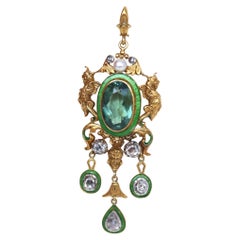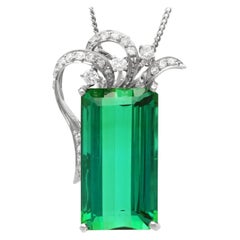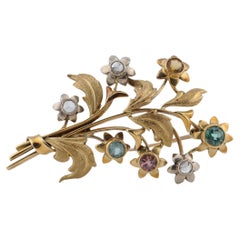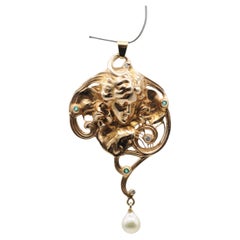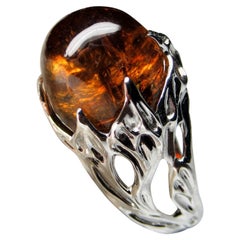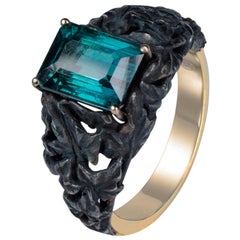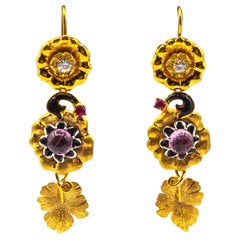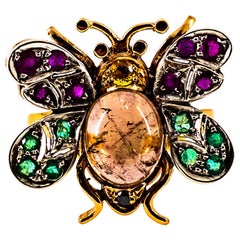Art Nouveau Tourmaline
Antique 1890s Art Nouveau Pendant Necklaces
Diamond, Tourmaline, Yellow Gold, Enamel
Vintage 1930s Pendant Necklaces
Diamond, Tourmaline, Platinum
20th Century German Art Nouveau Brooches
Citrine, Diamond, Tourmaline, Apatite, Gold, 14k Gold, Yellow Gold
Antique 19th Century French Art Nouveau Pendant Necklaces
Diamond, Pearl, Tourmaline, Gold, 14k Gold, Yellow Gold
2010s French Art Nouveau Fashion Rings
Tourmaline, Gold, 14k Gold, White Gold
2010s French Art Nouveau Engagement Rings
Tourmaline, Indicolite, Gold, 18k Gold, Silver, Yellow Gold
21st Century and Contemporary Balinese Art Nouveau Fashion Rings
Tourmaline, 18k Gold, Yellow Gold
Late 20th Century Italian Art Nouveau Stud Earrings
Diamond, White Diamond, Ruby, Tourmaline, 9k Gold, Yellow Gold, Sterling...
Late 20th Century Italian Art Nouveau Cocktail Rings
Diamond, White Diamond, Emerald, Ruby, Sapphire, Blue Sapphire, Yellow S...
21st Century and Contemporary Italian Art Deco Beaded Necklaces
Amethyst, Aquamarine, Chalcedony, Chrysophrase, Citrine, Tourmaline, Tur...
Mid-20th Century Italian Art Nouveau Retro Bracelets
Amethyst, Citrine, Diamond, White Diamond, Emerald, Pearl, Cultured Pear...
2010s French Art Deco Bridal Rings
Tourmaline, Indicolite, Gold, 18k Gold, Yellow Gold, Silver
2010s French Aesthetic Movement Dangle Earrings
Rubelite, Tourmaline, 14k Gold, Yellow Gold, Gold
2010s American Artisan Drop Necklaces
Diamond, White Diamond, Tourmaline, 18k Gold, White Gold
21st Century and Contemporary Indian Art Nouveau Charm Bracelets
Tourmaline, 18k Gold, White Gold
Late 20th Century Italian Art Nouveau Stud Earrings
Diamond, White Diamond, Ruby, Tourmaline, Turquoise, 9k Gold, Yellow Gol...
21st Century and Contemporary Italian Art Nouveau Lever-Back Earrings
Aquamarine, Diamond, White Diamond, Emerald, Ruby, Sapphire, Yellow Sapp...
Late 20th Century Italian Art Nouveau Lever-Back Earrings
Diamond, White Diamond, Ruby, Tourmaline, Turquoise, Amethyst, 9k Gold, ...
Late 20th Century Italian Art Nouveau Stud Earrings
Diamond, White Diamond, Ruby, Tourmaline, 9k Gold, Yellow Gold, Sterling...
21st Century and Contemporary Italian Art Nouveau Lever-Back Earrings
Aquamarine, Diamond, White Diamond, Emerald, Ruby, Sapphire, Blue Sapphi...
21st Century and Contemporary Italian Art Nouveau Lever-Back Earrings
Aquamarine, Diamond, White Diamond, Emerald, Ruby, Sapphire, Blue Sapphi...
21st Century and Contemporary Italian Art Nouveau Lever-Back Earrings
Aquamarine, Diamond, White Diamond, Emerald, Ruby, Sapphire, Blue Sapphi...
Late 20th Century Italian Art Nouveau Lever-Back Earrings
Diamond, White Diamond, Ruby, Topaz, Tourmaline, Turquoise, Blue Topaz, ...
21st Century and Contemporary Afghan Art Nouveau Loose Gemstones
Tourmaline
Late 20th Century Italian Art Nouveau Stud Earrings
Diamond, White Diamond, Ruby, Tourmaline, Turquoise, Topaz, Blue Topaz, ...
21st Century and Contemporary Italian Art Nouveau Lever-Back Earrings
Aquamarine, Diamond, White Diamond, Emerald, Ruby, Sapphire, Blue Sapphi...
2010s French Art Nouveau Pendant Necklaces
Crystal, Rubelite, Tourmaline, Silver, Sterling Silver
2010s German Art Nouveau Pendant Necklaces
Crystal, Tourmaline, Gold, 14k Gold, Yellow Gold
Early 20th Century Art Nouveau Link Necklaces
Diamond, Moonstone, Tourmaline, 18k Gold, Yellow Gold
21st Century and Contemporary Italian Art Deco Drop Earrings
Diamond, White Diamond, Emerald, Ruby, Tourmaline, Turquoise, 9k Gold, Y...
21st Century and Contemporary American Art Nouveau Pendant Necklaces
Tourmaline, 18k Gold, Yellow Gold
2010s Hong Kong Art Nouveau Band Rings
Onyx, Tourmaline, 18k Gold
2010s Hong Kong Art Nouveau Solitaire Rings
Tourmaline, 18k Gold, Enamel
21st Century and Contemporary Afghan Art Nouveau Loose Gemstones
Tourmaline
21st Century and Contemporary Indian Art Nouveau Pendant Necklaces
Chalcedony, Diamond, Tourmaline, 14k Gold, Yellow Gold
2010s Japanese Art Nouveau Cocktail Rings
Tanzanite, Tourmaline, 18k Gold
21st Century and Contemporary Indian Art Nouveau Dangle Earrings
Tourmaline, Tanzanite, 18k Gold, White Gold
21st Century and Contemporary Indian Art Nouveau Pendant Necklaces
Onyx, Tourmaline, 18k Gold, Yellow Gold
21st Century and Contemporary Indian Art Nouveau Lever-Back Earrings
Onyx, Tourmaline, 18k Gold, White Gold
21st Century and Contemporary Art Nouveau Pendant Necklaces
Diamond, Tourmaline, 18k Gold, Rose Gold
2010s French Art Nouveau Pendant Necklaces
Crystal, Rubelite, Tourmaline, Silver, Sterling Silver
21st Century and Contemporary Afghan Art Nouveau Loose Gemstones
Rubelite, Tourmaline
21st Century and Contemporary Afghan Art Nouveau Loose Gemstones
Tourmaline
21st Century and Contemporary Afghan Art Nouveau Loose Gemstones
Tourmaline, Indicolite
2010s French Art Nouveau Pendant Necklaces
Crystal, Tourmaline, Gold, 14k Gold, Yellow Gold
21st Century and Contemporary Afghan Art Nouveau Loose Gemstones
Multi-gemstone, Tourmaline, Other
21st Century and Contemporary Indian Art Nouveau Drop Earrings
Emerald, Onyx, Tourmaline, 18k Gold, Yellow Gold
21st Century and Contemporary Indian Art Nouveau Dangle Earrings
Tourmaline, Diamond, 18k Gold, Silver
21st Century and Contemporary American Art Nouveau Bangles
Tourmaline, Silver, Sterling Silver
2010s French Art Nouveau Pendant Necklaces
Crystal, Tourmaline, Gold, 14k Gold, Yellow Gold
21st Century and Contemporary German Art Nouveau Pendant Necklaces
Diamond, Tourmaline, 18k Gold, Rose Gold
2010s Indian Art Nouveau Modern Bracelets
Diamond, Tourmaline, Gold Plate, Sterling Silver, Silver
Early 20th Century Unknown Art Nouveau Pendant Necklaces
Amethyst, Tourmaline, White Gold, Enamel, Rhodium, Gilt Metal
21st Century and Contemporary Afghan Art Nouveau Loose Gemstones
Multi-gemstone, Tourmaline, Other
21st Century and Contemporary Indian Art Nouveau Lever-Back Earrings
Amethyst, Diamond, Pink Sapphire, Tourmaline, 18k Gold, White Gold
2010s Afghan Art Nouveau Cocktail Rings
Diamond, Tourmaline, 14k Gold, White Gold
21st Century and Contemporary Asian Art Nouveau Chain Necklaces
Yellow Sapphire, Tourmaline, Yellow Gold
21st Century and Contemporary German Art Nouveau Pendant Necklaces
Diamond, Tourmaline, 18k Gold, Rose Gold
- 1
Art Nouveau Tourmaline For Sale on 1stDibs
How Much is a Art Nouveau Tourmaline?
A Close Look at Art-nouveau Jewelry
Art Nouveau — generally considered to have begun in the late 1800s and ended with the start of World War I — was a movement in the decorative arts that drew inspiration from natural forms, such as trees, flowers and, of course, the human figure. The three main themes present in Art Nouveau jewelry and watches were flora, fauna and women.
Art Nouveau, which reached its pinnacle in the year 1900, spawned from artists who rejected the historicism of their predecessors to create an entirely new visual vocabulary. As compared to Art Deco jewelry’s geometric patterns and sharp lines, the extravagant style of antique Art Nouveau jewelry is characterized by curvilinear forms and whiplash lines, vibrant materials and dramatic imagery.
The first art and design movement of the 20th century, Art Nouveau was also a reaction against the Industrial Revolution, and took its inspiration from the theories of the Symbolists, the art of the Pre-Raphaelites, the ideas of John Ruskin and his follower William Morris and, most importantly Japanese crafts. (The country was a fertile ground for inspiration after it was opened to the West in 1854.) The Art Nouveau style touched all manners of the arts, including the most exultant jewelry.
Nature was a favorite muse for artists going back to the 18th and 19th centuries, but in the hands of 20th-century artists, it was depicted in new ways. For example, a withering flower was considered just as beautiful as one in full bloom. Winged creatures, such as insects and birds, were also a popular subject. Dragonflies and butterflies were particular favorites because they morphed so dramatically in different life stages.
This was also a reference to women, whose role in society was evolving. It was not uncommon to see a piece of jewelry that would at once reference a woman as a winged creature (think René Lalique’s famous Dragonfly brooch, circa 1897–98, at the Gulbenkian Collection in Lisbon). However, just as women’s roles were ambiguous, so was their image, as the femmes nouvelle were simultaneously eroticized and romanticized.
In addition to Lalique, vital figures in Art Nouveau jewelry included Louis Comfort Tiffany in the United States, Vladimir Soloviev, who designed jewelry for Peter Carl Fabergé in Russia, Fuset Grau of Spain, Karl Rothmuller of Germany and Philippe Wolfers of Belgium.
Art Nouveau jewelers used every “canvas” imaginable, looking beyond brooches and necklaces to belt buckles, fans, tiaras, dog collars (a type of choker necklace), pocket watches, corsages and hair combs. Multicolored gems and enamel could complete this vision better than diamonds. Jewelers also favored pearls, particularly baroque pearls, for their large size and irregular shape. However, opal was the most popular stone — its iridescence harmonized perfectly with the enamel, and it could be carved into any shape. Art Nouveau jewelry was primarily set in yellow gold.
Find a range of antique Art Nouveau jewelry today on 1stDibs.
Why Gold Shines in Jewelry Craftsmanship
Gold is the feel-good metal, the serotonin of jewelry. Wear vintage and antique gold necklaces, watches, gold bracelets or gold rings and you feel happy, you feel dressed, you feel, well, yourself.
Gold, especially yellow gold, with its rich patina and ancient pedigree going back thousands of years, is the steady standby, the well-mannered metal of choice. Any discussion of this lustrous metal comes down to a basic truth: Gold is elementary, my dear. Gold jewelry that couples the mystique of the metal with superb design and craftsmanship achieves the status of an enduring classic. Many luxury houses have given us some of our most treasured and lasting examples of gold jewelry over the years.
Since its founding, in 1837, Tiffany & Co. has built its reputation on its company jewelry as well as its coterie of boutique designers, which has included Jean Schlumberger, Donald Claflin, Angela Cummings and Elsa Peretti. There are numerous gold Tiffany classics worth citing. Some are accented with gemstones, but all stand out for their design and the workmanship displayed.
For the woman who prefers a minimalist look, the Tiffany & Co. twist bangle (thin, slightly ovoid) is stylishly simple. For Cummings devotees, signature pieces feature hard stone inlay, such as her pairs of gold ear clips inlaid with black jade (a play on the classic Chanel black and tan), or bangles whose design recalls ocean waves, with undulating lines of lapis lazuli and mother-of-pearl. And just about any design by the great Jean Schlumberger is by definition a classic.
Even had he eschewed stones and diamonds, Southern-born David Webb would be hailed for the vast arsenal of heavy gold jewelry he designed. Gold, usually hammered or textured in some manner, defines great David Webb jewelry. The self-taught jeweler made very au courant pieces while drawing inspiration from ancient and out-of-the-way sources — East meets West in the commanding gold necklaces made by Webb in the early 1970s. The same could be said for his endlessly varied gold cuffs.
In Europe, many houses have given us gold jewelry that sets the highest standard for excellence, pieces that were highly sought after when they were made and continue to be so.
Numerous designs from Cartier are homages to gold. There are the classic Trinity rings, necklaces and bracelets — trifectas of yellow, white and rose gold. As a testament to the power of love, consider the endurance of the Cartier Love bracelet.
Aldo Cipullo, Cartier’s top in-house designer from the late 1960s into the early ’70s, made history in 1969 with the Love bracelet. Cipullo frequently said that the Love bracelet was born of a sleepless night contemplating a love affair gone wrong and his realization that “the only remnants he possessed of the romance were memories.” He distilled the urge to keep a loved one close into a slim 18-karat gold bangle.
BVLGARI and its coin jewelry, gemme nummarie, hit the jackpot when the line launched in the 1960s. The line has been perennially popular. BVLGARI coin jewelry features ancient Greek and Roman coins embedded in striking gold mounts, usually hung on thick link necklaces of varying lengths. In the 1970s, BVLGARI introduced the Tubogas line, most often made in yellow gold. The Tubogas watches are classics, and then there is the Serpenti, the house's outstanding snake-themed watches and bracelets.
A collection called Monete that incorporated the gold coins is one of several iconic BVLGARI lines that debuted in the 1970s and ’80s, catering to a new generation of empowered women. Just as designers like Halston and Yves Saint Laurent were popularizing fuss-free ready-to-wear fashion for women on the go, BVLGARI offered jewels to be lived in.
Since Van Cleef & Arpels opened its Place Vendôme doors in 1906, collection after collection of jewelry classics have enchanted the public. As predominantly expressed in a honeycomb of gold, there is the Ludo watch and accessories, circa the 1920s, and the golden Zip necklace, 1951, whose ingenious transformation of the traditional zipper was originally proposed by the Duchess of Windsor. Van Cleef's Alhambra, with its Moroccan motif, was introduced in 1968 and from the start its popularity pivoted on royalty and celebrity status. It remains one of VCA’s most popular and collected styles.
Mention must be made of Buccellati, whose name is synonymous with gold so finely spun that it suggests tapestry. The house’s many gold bracelets, typically embellished with a few or many diamonds, signified taste and distinction and are always in favor on the secondary market. Other important mid-20th-century houses known for their gold-themed jewelry include Hermès and Ilias Lalaounis.
Find a stunning collection of vintage and antique gold jewelry on 1stDibs.
The Legacy of Tourmaline in Jewelry Design
Very few gems dazzle quite in the manner that tourmaline does — vintage and antique tourmaline jewelry is a showstopper, and you can blame this on its wide range of spectacular colors. In fact, when Dutch traders brought stones back home from Sri Lanka that they couldn't identify, they called them "toramalli," a Sinhalese term for "mixed gems."
If you could transform the ocean to a gem, this is what it would look like: a clear, translucent azure, bordering on turquoise, hypnotizing in its depth and sparkling in the sun.
There is, in fact, such a stone, although it comes from deep in the copper-rich mountains of Paraíba, Brazil, and not from the oceans along its coast. Far rarer than diamonds, Paraíba tourmaline, a kind of tourmaline discovered only in the 1980s, is treasured as much for its extraordinary color as its scarcity, both of which contribute to its high value.
While diamonds generally sell for about $6,000 per carat, a carat of Paraíba tourmaline is likely to fetch about $16,000. Fans of the gem are said to include singer Taylor Swift and actress Zooey Deschanel, as well as some of the finest jewelers.
“No other stone can have a color as magnetic and captivating as Paraíba tourmaline,” says Vania Leles of VanLeles Diamonds, who combines the stone with diamonds and other gems in several of her designs.
You don't have to stop at Paraíba tourmaline jewelry — on 1stDibs, find the most extraordinary antique and vintage tourmaline rings, tourmaline and diamond earrings and other accessories.
- Why did Art Nouveau end?1 Answer1stDibs ExpertAugust 8, 2024Art Nouveau ended primarily due to world events. When World War I broke out in 1914, artistic production was largely halted in order to free up materials for manufacturing equipment for the war effort. By the time the 1919 Treaty of Versailles brought about the end of the war, interest in Art Nouveau had waned. Designers and artists became interested in new forms and styles, such as Art Deco. On 1stDibs, explore a diverse assortment of Art Nouveau furniture, decorative objects, jewelry and art.
- What is Art Nouveau furniture?1 Answer1stDibs ExpertAugust 15, 2019
Art Nouveau furniture was a style of furniture that emerged at the end of the 19th century and was characterized by its complex curved lines. The curved details in the furniture were typically carved by hand and finished with lacquer. The unmistakable gloss that is associated with Art Nouveau comes from the thick coat of varnish applied to the furniture as the final step of the production process.
- 1stDibs ExpertFebruary 27, 2024Art Nouveau was influenced by a few things. The soft colors and abstract images of nature seen in Japanese woodblock prints, which arrived in large numbers in the West after open trade was forced upon Japan in the 1860s, were a major source of inspiration. Also, Pre-Raphaelite art and the Arts and Crafts and Rococo styles had an influence on Art Nouveau designers. On 1stDibs, find a wide range of Art Nouveau furniture and decorative objects.
- What is Art Nouveau jewelry?1 Answer1stDibs ExpertNovember 2, 2021Art Nouveau jewelry generally featured three main themes: flora, fauna and women. The Art Nouveau movement lasted 15 years and it reached its pinnacle in the year 1900. Art Nouveau jewelers used every “canvas” imaginable, looking beyond brooches and necklaces to belt buckles, fans, tiaras, dog collars (a type of choker necklace), pocket watches, corsages and hair combs. Multicolored gems and enamel could complete this vision better than diamonds. Enameling is most often associated with Art Nouveau jewelry, specifically plique-à-jour. Known as backless enamel, plique-à-jour allows light to come through the rear of the enamel because there is no metal backing. It creates an effect of translucence and lightness. Shop a collection of antique and vintage Art Nouveau jewelry from some of the world’s top jewelers on 1stDibs.
- Where did Art Nouveau originate?1 Answer1stDibs ExpertMay 14, 2024Art Nouveau originated in France and Great Britain, but variants materialized elsewhere. The visual vocabulary of Art Nouveau was particularly influenced by the soft colors and abstract images of nature as portrayed in Japanese art prints, which arrived in large numbers in the West after open trade was forced upon Japan in the 1860s. Impressionist artists were moved by the artistic tradition of Japanese woodblock printmaking and other modes of art and design in the East Asian country. The Art Nouveau style quickly reached a wide audience in Europe via advertising posters, book covers, illustrations and other work by such artists as Aubrey Beardsley, Henri de Toulouse-Lautrec and Alphonse Mucha. While all Art Nouveau designs share common formal elements, different countries and regions produced their own versions. Explore a selection of Art Nouveau furniture, jewelry and art on 1stDibs.
- 1stDibs ExpertAugust 15, 2019
The main difference between Art Nouveau and Art Deco is that the former is detailed and ornate, and the latter is sharp and geometrical. When the movement started at the end of the 19th century, Art Nouveau was heavily influenced by nature and the curved lines of flowers. Art Deco, which became popular in the beginning of the 20th century, was inspired by the geometric abstraction of cubism.
- 1stDibs ExpertNovember 4, 2024To identify Art Nouveau furniture, first try to locate a maker's mark on the piece. You can then use it to research the maker with the help of information published in trusted online resources. Some makers, such as Charles Rennie Mackintosh, Louis Majorelle and Émile Gallé, are well-known for their Art Nouveau furnishings. If you determine that a maker identified with Art Nouveau produced your piece, it likely reflects the movement's characteristics, especially if it was made during the late 19th or early 20th centuries. You can also look for common features of Art Nouveau furniture, such as sinuous, organic and flowing lines; forms that mimic flowers and plant life; decorative inlays and ornate carvings of natural-world motifs such as insects and animals and the use of hardwoods such as oak, mahogany and rosewood. A certified appraiser or knowledgeable antique dealer can aid you with the identification process. Shop a diverse assortment of Art Nouveau furniture on 1stDibs.
- 1stDibs ExpertApril 5, 2024No one person created the Art Nouveau movement. However, the term debuted in an 1884 article in the L'Art Moderne journal, describing the work of a collective of artists known as Les XX. As a result, some people credit the group and its founding members, James Ensor and Théo van Rysselberghe, as helping to define the movement. However, Art Nouveau was heavily informed by work that came before, including Rococo design, Pre-Raphaelite art, Japanese art and the Arts and Crafts movement. Beyond Les XX, a number of creators helped to propel the movement. Among them were Charles Rennie Mackintosh, Louis Majorelle, Émile Gallé, Antoni Gaudí and Tiffany Studios. On 1stDibs, explore a diverse assortment of Art Nouveau furniture and decorative objects.
- 1stDibs ExpertAugust 15, 2019
The Art Nouveau design movement used such materials as cast iron and steel, ceramic and glass. This style of architecture, design, art and jewelry was characterized by its use of long, sinuous lines that are reflected in nature.
- Is stained glass Art Nouveau?1 Answer1stDibs ExpertApril 5, 2022Yes, some stained glass is Art Nouveau. It was during this period that Louis Comfort Tiffany produced his famed stained glass windows and decorative objects. However, the tradition of producing stained glass traces all the way back to the Gothic period. You'll find a selection of stained glass on 1stDibs.
- 1stDibs ExpertApril 5, 2022Alphonse Mucha was a Czech painter who is one of the originators of the Art Nouveau style. His style of painting and design rose in popularity in 1895 and he produced many works, including illustrations, posters and jewelry designs. Find a variety of Alphonso Mucha art and prints on 1stDibs.
- 1stDibs ExpertAugust 20, 2024To identify Art Nouveau jewelry, first consider its overall shape and themes. Flora, fauna and female figures were the three main themes in Art Nouveau jewelry. Winged creatures, such as insects and birds, were also popular subjects. Next, examine the materials and techniques. Art Nouveau jewelers distinguished themselves from their predecessors through the use of their unorthodox materials and methods. Prior to the 20th century, artisans working with jewelry prioritized precious metals and diamonds. This was not true for Art Nouveau creators. Enameling is most often associated with Art Nouveau jewelry, specifically plique-à-jour. Known as backless enamel, plique-à-jour allows light to come through the rear of the enamel because there is no metal backing. It creates an effect of translucence and lightness. Art Nouveau jewelers also favored pearls, particularly baroque pearls, for their large size and irregular shape. However, opal was the most popular stone, and Art Nouveau jewelry was primarily set in yellow gold. If you need more help identifying your jewelry, a certified appraiser or knowledgeable dealer can assist you. On 1stDibs, find a wide range of Art Nouveau jewelry.
Read More
Art Nouveau Master Alphonse Mucha Created Much More Than Parisian Posters
Aside from his iconic commercial prints, the Czech artist endeavored to make works that spoke to the soul.
Everything You’d Want to Know about Enamel Jewelry
From vibrant to subtle, elegant to cheeky, enamel jewelry encompasses a wide range of colors and styles, and there are almost as many techniques for creating these distinctive pieces.
What Makes Art Nouveau Jewelry So Collectible?
The first art and design movement of the 20th century was all about celebrating beauty of women and nature.
